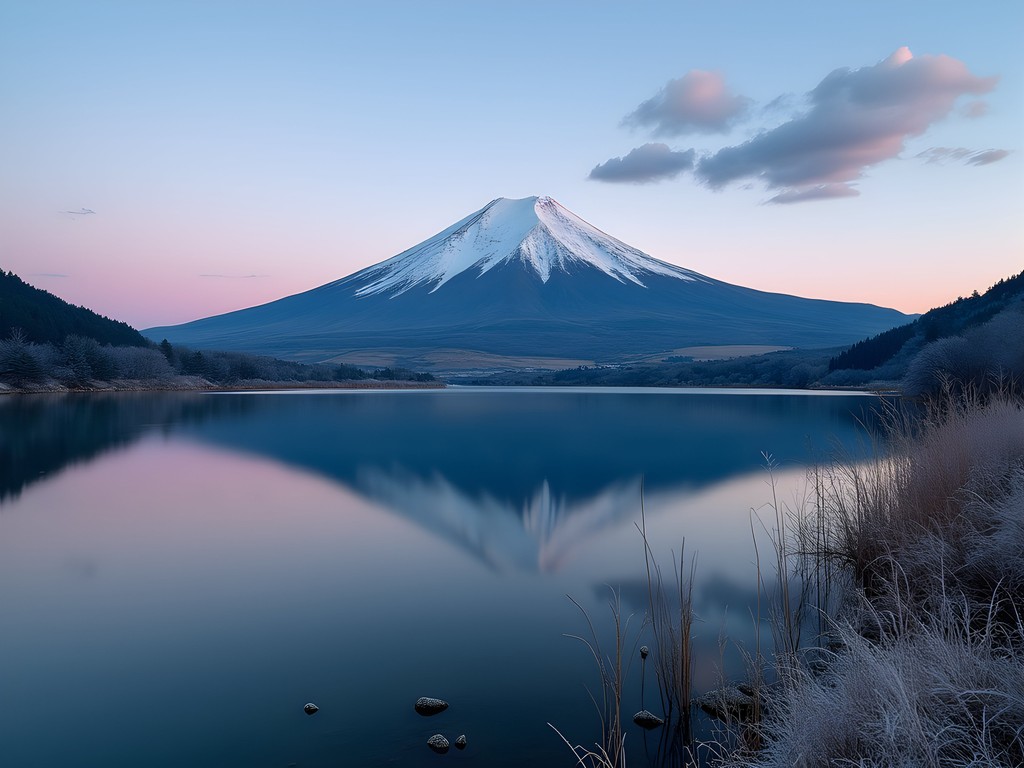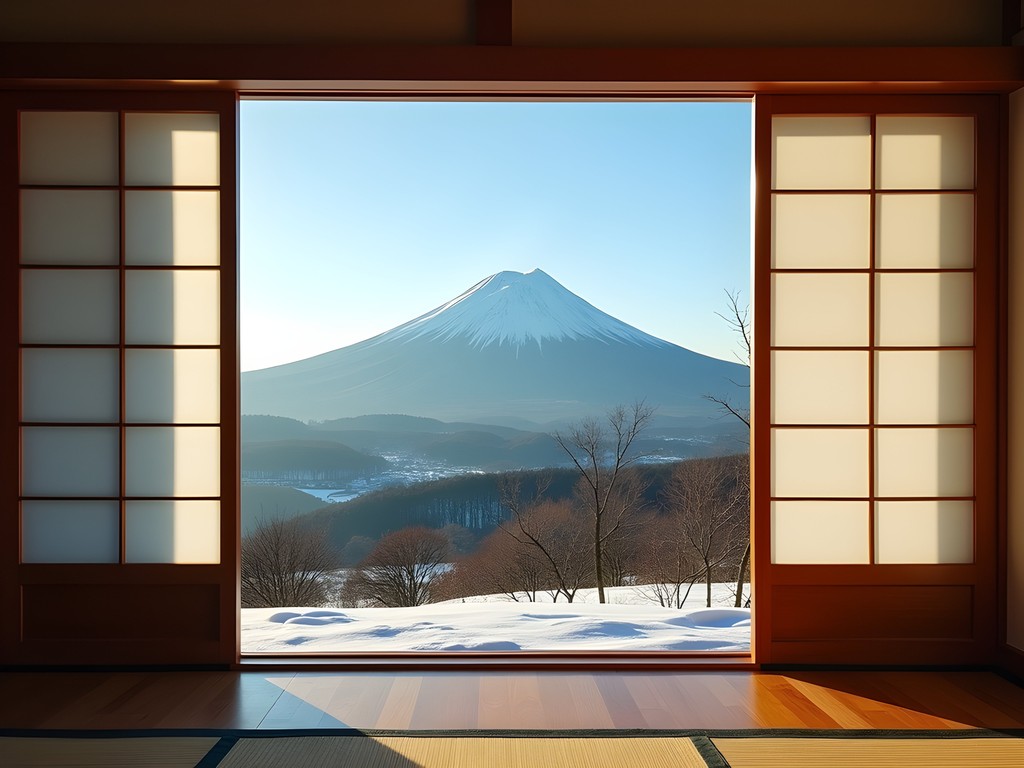Disclosure: This article contains affiliate links. We may earn a commission from purchases at no extra cost to you, which helps our travel content.
There's something profoundly humbling about standing before Mount Fuji for the first time. This perfect volcanic cone has captivated artists, poets, and now photographers for centuries, its symmetrical silhouette an enduring symbol of Japan's natural beauty. As both a conservation scientist and photography enthusiast, I've found that winter offers a magical combination of clear skies, snow-capped majesty, and fewer crowds—creating ideal conditions for capturing this iconic landscape in all its glory.
Understanding Mount Fuji's Winter Moods
My scientific background has taught me that understanding natural phenomena is the first step to capturing them effectively. Mount Fuji in winter is a study in contrasts and timing. From November through February, the mountain wears its distinctive snow cap, creating that classic postcard silhouette we all recognize.
What many don't realize is that Fuji is notoriously shy. The mountain is often shrouded in clouds, revealing itself fully for only a fraction of winter days. This atmospheric dance creates both challenges and opportunities for photographers.
During my week-long photography expedition, I learned to watch for the telltale signs of good visibility: cold fronts that bring crisp, clean air, and the hours immediately after dawn when clouds are least likely to obscure the peak. The Japanese have a saying: ichigo ichie (one time, one meeting)—a reminder to treasure each fleeting moment with the mountain as a unique encounter.
I found my weather station invaluable for tracking conditions. While this might seem excessive for travel, having real-time data on wind direction (which affects cloud formation around Fuji) and barometric pressure helped me anticipate when the mountain would make its grandest appearances.

💡 Pro Tips
- Track weather forecasts obsessively—apps like Japan Meteorological Agency's website provide Fuji-specific visibility predictions
- Cold, clear days after rainfall or snowfall offer the best visibility
- Early morning (before 9am) typically provides the clearest views before clouds form
Prime Photography Locations Around the Mountain
After extensive research and conversations with local photographers, I identified several key vantage points that offer distinct perspectives of Fuji-san. Each location has its own character and optimal shooting times.
Lake Kawaguchiko quickly became my favorite for its accessibility and variety. The northern shore provides that classic reflection shot when conditions are still, while the eastern end offers compositions with traditional Japanese architecture framing the mountain. I spent three consecutive mornings at Oishi Park along the northern shore, each day revealing a slightly different mood as changing winter light painted the scene.
Chureito Pagoda in Fujiyoshida City delivers perhaps the most iconic view—the five-story vermilion pagoda with Fuji looming majestically behind it. In winter, the scene is particularly striking when snow dusts the pagoda roof. The climb up 398 steps is challenging in cold weather, but my hand warmers were absolute lifesavers for maintaining dexterity while adjusting camera settings with bare fingers.
Lake Tanuki in Fujinomiya offers a less-visited perspective with excellent foreground elements. The small torii gate at the water's edge creates compelling compositions, especially at sunset when Fuji's western face catches the last light.
For aerial perspectives, I splurged on a drone before this trip—a worthwhile investment that allowed me to capture unique angles impossible to achieve from ground level. Just remember to research Japan's strict drone regulations beforehand and obtain necessary permissions.

💡 Pro Tips
- Visit each location at different times of day—the mountain's appearance transforms dramatically with changing light
- Pack microfiber cloths for lens condensation issues when moving between warm vehicles and cold exteriors
- Use apps like PhotoPills to plan exact sunrise/sunset positions relative to Mount Fuji
Technical Considerations for Winter Photography
Winter photography around Mount Fuji presents unique technical challenges that I wasn't fully prepared for despite my experience shooting in New Zealand's variable conditions.
First and foremost: battery management. The cold temperatures depleted my camera batteries at an alarming rate—reducing their capacity by nearly 60%. My solution was keeping spare batteries in an insulated battery pouch close to my body heat. This simple adaptation made a tremendous difference in my shooting longevity.
The extreme contrast between bright snow and dark forests demands careful exposure management. I consistently bracketed my shots (taking multiple exposures at different settings) and relied heavily on my camera's histogram display rather than the LCD preview, which can be deceptive in bright conditions. When processing later, I found that polarizing filter had been invaluable for controlling reflections on lakes and enhancing the blue sky contrast against Fuji's white peak.
Another winter-specific challenge was condensation forming on my lenses when moving between heated transportation and the frigid outdoors. Rather than immediately removing gear from my bag, I learned to let my equipment gradually acclimate to temperature changes by keeping it in my camera bag for 15-20 minutes before use.
For those serious about landscape photography, I'd recommend investing in a solid graduated ND filter set. These were essential for balancing the exposure between bright sky and darker foreground elements without creating unnatural-looking HDR composites.

💡 Pro Tips
- Keep spare batteries warm in inner pockets close to your body
- Use a lens hood to prevent snowflake accumulation on front elements
- Consider using hand/foot warmers inside gloves and boots for extended shooting sessions
Cultural Context and Environmental Sensitivity
As both a conservation scientist and visitor, I believe understanding the cultural and ecological significance of what we photograph enriches the experience immeasurably.
Mount Fuji is not merely a picturesque landmark—it's a sacred site in the Shinto religion, considered the dwelling place of a goddess. This spiritual significance has influenced my approach to photography there, fostering a deeper respect for the mountain beyond its aesthetic qualities.
During my research visit to the Fujisan World Heritage Center in Fujiyoshida, I learned about the ecological pressures facing the mountain, from increased tourism to climate change impacts on its iconic snow cap. The conservation biologist in me couldn't help but note how winter snow patterns have changed over decades—a sobering reminder of our changing climate.
This awareness has influenced my photographic choices. Rather than venturing into restricted areas for "unique" angles, I've found creative ways to capture the mountain from designated viewpoints. When hiking the lower slopes, I've adhered strictly to marked trails to minimize vegetation impact.
I also made a point to support local communities by staying at a family-run ryokan rather than a chain hotel. My host, Tanaka-san, shared fascinating local perspectives on Fuji-san that informed my photographic approach. She also introduced me to a wonderful travel thermos that kept my tea hot through long pre-dawn shooting sessions—a seemingly small detail that made those cold mornings much more bearable.

💡 Pro Tips
- Visit the Fujisan World Heritage Center to understand the mountain's cultural and ecological significance
- Support local businesses and seek local knowledge about less-known viewpoints
- Consider how your images might contribute to conservation awareness
Beyond the Postcard: Finding Unique Perspectives
After a few days of capturing the classic Fuji views, I felt compelled to search for more personal interpretations. This quest for unique perspectives led me down less-traveled paths and into fascinating encounters.
One breakthrough came when I ventured to the small shrine of Kitaguchi Hongu Fuji Sengen in Fujiyoshida. Unlike the famous Chureito Pagoda nearby, this ancient shrine was virtually empty of photographers. The massive torii gate frames Fuji perfectly, while the shrine's weathered wooden structures provided rich foreground interest without the crowds.
Another discovery was the value of inclement weather. While most photographers pack up during snowfall, I found that light snow creates atmospheric layers that add depth to images. During one afternoon snowshower, I captured Fuji partially veiled by falling snow—creating a moody, ethereal quality distinctly different from the typical clear-sky shots.
For truly unique compositions, I experimented with my telephoto lens to isolate abstract patterns on Fuji's slopes. The interplay of snow, rock, and shadow revealed fascinating textures invisible to the naked eye.
One evening, seeking shelter from biting wind, I ducked into a small local bookstore and discovered a collection of historical Fuji photographs dating back to the 1800s. This photo history book became both souvenir and inspiration, showing how the mountain has been interpreted across generations. The elderly shopkeeper, noticing my interest, shared locations where his grandfather had photographed the mountain—spots now forgotten by modern photo guides.

💡 Pro Tips
- Look for frames within frames—architectural elements, trees, or even people that create natural borders around the mountain
- Don't put your camera away during 'bad' weather—snow, mist and clouds can create atmospheric effects impossible to capture on clear days
- Study historical photographs of Fuji for inspiration beyond contemporary social media trends
Final Thoughts
As I packed away my gear on the final morning of my Fuji pilgrimage, I reflected on how this iconic mountain had challenged and changed me as both photographer and scientist. Beyond the technical skills honed through trial and error in winter conditions, I gained a deeper appreciation for the intersection of cultural reverence and natural wonder that Fuji-san represents.
What began as a quest for perfect postcard shots evolved into something more meaningful—a visual exploration of how humans relate to this sacred landmark across time, seasons, and perspectives. My scientific training taught me to observe patterns and relationships in ecosystems; here, I found myself documenting the relationship between a mountain and the culture that has venerated it for centuries.
As climate change threatens to reduce Fuji's iconic snow cap in coming decades, our photographs take on additional significance as documentation of a landscape in transition. I encourage fellow photographers to approach Fuji not just as a subject to be captured, but as a teacher offering lessons in patience, respect, and the ephemeral nature of beauty.
When you visit, take the iconic shots—they're famous for good reason—but then challenge yourself to find your own unique conversation with the mountain. Like the countless artists before us who have interpreted this perfect cone, what will your personal vision of Fuji contribute to its ongoing visual story?
✨ Key Takeaways
- Winter offers spectacular photography conditions for Mount Fuji but requires preparation for cold weather challenges
- The best photographs often come from understanding the mountain's moods, patterns and cultural significance rather than just technical skill
- Supporting local communities and respecting environmental guidelines enhances both your experience and your images
📋 Practical Information
Best Time to Visit
December-February for snow-capped views, with January offering the clearest visibility
Budget Estimate
$1,500-$2,500 for one week (including accommodation, transportation, and equipment rentals)
Recommended Duration
5-7 days to account for weather variability
Difficulty Level
Moderate (Requires Early Mornings, Cold Weather Tolerance, And Some Hiking)











Comments
MountainLens
Don't forget to check for special winter light-up events at the Chureito Pagoda! They usually run from late December through February and create amazing night photography opportunities with the illuminated pagoda and Fuji in the background.
luckychamp
This is EXACTLY the guide I needed!! Heading to Japan next month and Fuji is top of my list! Did you find it difficult to access Lake Kawaguchiko in winter? I've heard some roads can be closed!
Emilia Tucker
The main roads to Kawaguchiko remain open year-round, but some of the higher elevation viewpoints can be inaccessible after heavy snow. The train from Tokyo to Kawaguchiko Station runs reliably even in winter. Just check the weather forecast before heading out!
luckychamp
Thank you so much! Can't wait to try capturing those reflection shots you mentioned!
Frank Garcia
Excellent guide, Emilia! Your analysis of how weather conditions affect visibility is spot-on. I spent three weeks photographing Fuji last winter and can confirm that early mornings (5-7am) consistently provided the clearest views. One location I'd add to your list is the Oshino Hakkai ponds - when the water is still, the reflection doubles the impact of your composition. Also worth noting that the Fujigoko region can experience rapid weather shifts, so I'd recommend photographers pack multiple lens options and a weather-sealed body if possible. My mirrorless setup handled the conditions perfectly, even during light snowfall.
luckychamp
Oshino Hakkai is amazing! Got some of my best shots there last year. The early morning mist rising off those ponds is magical.
Frank Garcia
Exactly! The mist adds such a beautiful ethereal quality. Were you there during autumn by any chance? The combination of fall colors, mist, and Fuji is unbeatable.
journeywalker
Your sunrise shots are absolutely breathtaking! Did you really camp out all night for those?
Emilia Tucker
Thanks journeywalker! Yes, I did camp overnight at Chureito Pagoda. The temperatures dropped below freezing, but that magical morning light was worth every shivering moment!
journeywalker
Wow, serious dedication! I'm not sure I could handle those temps but the results speak for themselves.
Douglas Bradley
This guide is exactly what I needed! I've been researching Mount Fuji photography spots for months, and your breakdown of the five lakes region is incredibly helpful. I'm particularly intrigued by the Chureito Pagoda vantage point you mentioned - the cultural element with the mountain backdrop creates such compositional depth. One question though: how did you manage transportation between the different shooting locations? Did you rent a car or rely on public transit? I've heard conflicting advice about the accessibility of some of these spots in winter conditions.
Emilia Tucker
Thanks Douglas! I actually used a mix of both. Rented a car for the more remote spots like the northern shore of Lake Motosuko, but used public transit around Kawaguchiko where it's quite efficient. Just be prepared for early morning taxi rides if you're chasing sunrise - the buses don't always run that early!
Douglas Bradley
That's super helpful, Emilia. I think I'll follow your approach with the mixed transportation. Did you find your tripod sufficient for the winter conditions? I'm debating whether I need something more substantial for potential wind.
freerider3974
Jumping in here - I shot Fuji last winter and definitely needed a sturdy tripod. Those lakeshores get crazy windy!
freerider3974
Those sunrise shots are absolutely killer! Been wanting to photograph Fuji for years.
Douglas Bradley
Agreed! Emilia really captured the essence of winter Fuji. I'm planning a trip in February to try my hand at those reflection shots from Lake Kawaguchiko.
freerider3974
Nice! Let us know how it goes. I hear February can be hit or miss with cloud cover.
Sage Dixon
Emilia, your post brought back so many memories! I spent two weeks circling Fuji last winter, and it truly changes personality with every viewing angle and weather condition. For anyone planning a photography trip there, I'd add that the Hakone region offers some unique perspectives that aren't as commonly photographed. The view from Owakudani with the volcanic steam rising in the foreground creates this otherworldly frame. Just be prepared for the cold - my fingers nearly froze solid despite wearing gloves while setting up long exposures at dawn! Worth every minute of discomfort though. Your section on cultural sensitivity was particularly appreciated - I witnessed too many photographers trampling protected areas just to get "the shot."
tripchamp
Which viewpoint do you think is best for sunrise? Chureito Pagoda looks amazing but I've heard it gets super crowded.
Sage Dixon
Not the author but I was just there last month! Chureito is indeed packed at sunrise. Try Lake Kawaguchiko's northern shore instead - specifically the area near Oishi Park. Fewer photographers and you get those gorgeous reflections when the lake is calm. Arrived 45 minutes before sunrise and had plenty of space to set up. The morning mist rising off the lake with Fuji in the background was pure magic!
tripchamp
Thanks for the insider tip! Adding Oishi Park to my itinerary now.
Jean Wells
Having photographed Fuji through all seasons for over a decade, I'd add that winter photographers should be aware of the microclimate patterns. The mountain creates its own weather system, and understanding this can dramatically improve your success rate. The 'lenticular cloud' formations that often cap Fuji (locals call them 'kasagumo' or umbrella clouds) typically form in the afternoon when humidity and wind conditions align. For clear views, your statistical best bet is early morning, particularly 30-60 minutes before sunrise. December through February offers the most consistent visibility, though the coldest conditions. Don't overlook the potential of telephoto compression shots from distant locations like the Miho no Matsubara pine grove in Shizuoka, where you can capture Fuji with interesting foreground elements at 70-200mm.
Emilia Tucker
Jean, this is absolutely gold! Thank you for sharing your wealth of experience. I'm planning a return trip to focus on those telephoto compression shots - Miho no Matsubara just made it to the top of my list!
JapanFanatic
Just wow! Your photos make me want to book a flight right now!
Venture X
Premium card with 2X miles, $300 travel credit, Priority Pass